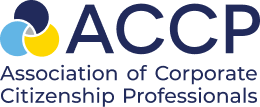Carolyn S. Berkowitz, ACCP
Research indicates that 97% of large companies in America have some type of EmployeeAssistance Fund (EAF), and not surprisingly, EAFs have become a top priority for corporate social responsibility (CSR) professionals in the face of the COVID-19pandemic. Whether employees or their family members fall ill, are furloughed or laid off, or have other related hardships, corporations around the country are looking to quickly leverage their EAFs as they focus a growing portion of their CSR efforts inward.
Typically, an EAF is created to assist employees financially when they face an unexpected hardship, e.g. high medical expenses, a funeral, or an uninhabitable home after disaster. Donations to the fund are made several ways: a one-time or periodic gift from the employer, fellow employee contributions, and sometimes through fundraising activities. EAFs require a set of guidelines that govern the fund including criteria for who is eligible, the nature of allowable hardships, the maximum dollar amount, and the individual or group accountable for allocation decisions. These are all carefully put in place when an EAF is created.
But in the face of this pandemic, corporations are seeking ways to be more responsive with their hardship funds. Over the past two weeks, ACCP has talked with CSR leaders from more than 100 corporations and heard from many about the steps they are taking to quickly expand and/or streamline their EAFs.
Here are some common strategies we’ve heard that you may consider:
Increase Funding for an Existing EAF
Allocate existing or expanded corporate contributions to the EAF
- Allow employees to cash out their paid time off (PTO) and donate it to the EAF
- Allow employees to donate stock to the fund
- Allow employees to take voluntary pay cuts to support the fundACCP member companies such as United Airlines, Southwest, Disney, Comcast and more, CEOs and/or other senior executives are taking pay cuts to support their employees, and many are also donating their pay differential to the company’s EAF.
Change EAF Guidelines to Enhance Flexibility
Expand the parameters of EAF guidelines to make funds more accessible by:
- Waiving a requirement for minimum time employed by the company,
- Being more flexible about the definition and criteria for hardships
- Changing the maximum grant limit in one of two ways – either increasing the dollar amount to provide more comprehensive support or decreasing the existing grant limit to assist a greater number of employees (using the federal government stimulus funding as a guide)
Streamline the process for applying for and receiving funds:
- Make the application easier to find on the website or in HR packets, and create a less cumbersome application form
- Create a leaner decision-making process in order to act quickly
- Determine the possible needs of employees in advance and anticipate costs to meet those needs, so allocations are easy to execute
- Make paid time off days an option for payout from the EAF or allow employees to cash-in their own PTO to self-fund
- Use the EAF fund as a “last resort” internally by making core business changes instead, such as increasing the number of PTO days, and increasing hourly workers pay rate
Clearly Communicate with Employees Regarding the Fund
- Communicate clearly about the fund and the process for accessing it with affected employees. Because they may be distracted by current circumstances, be sure to provide extra assistance to those impacted.
- Communicate regularly about the fund to all employees so they are aware they may donate dollars or PTO hours to their colleagues who are struggling.
One important note, corporate foundations cannot normally fund EAFs because that is considered a form of “self-dealing.” However, when a National Emergency is declared, some legal restrictions for corporate foundations are loosened, including an exception to the self-dealing rules. This exception now permits employer-sponsored private foundations to aid employees or family members who are affected by the coronavirus, subject to certain standards and requirements (Venable,Company Foundations and Coronavirus Response, March 18, 2020). This opens the corporate foundation to be another funding vehicle for the EAF. ACCP is developing member webcasts that will further address this issue.
While it’s not ideal to establish an EAF during a time of crisis, it is possible to act more quickly by partnering with a local community foundation on a donor-advised fund (DAF). In this case, fund guidelines still need to be created and decision-makers appointed, but the fund can be created in a matter of weeks, rather than months.
Here some resources on EAFs that might be helpful:
- KPMG: Report on Providing EAFs
- YourCause: Creating an Employee Assistance Fund
- Venable: Company Foundations and CoronavirusResponse
We would love to hear from you on ways you’re adapting your company’s EAF to meet your employees’ needs right now. Please engage with our team either by posting in the ACCP Communities, or by emailing Dana Frazeur, to share examples of your work that can be instructive to others. We will only attribute the example to your company if you explicitly allow us to.
If you are an ACCP member, join the conversation in the ACCP Communities for the most up-to-date information, or you can access a compilation of our members’ press releases to learn about what others are doing.
Next up: Virtual volunteering
